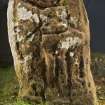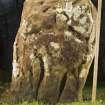Pricing Change
New pricing for orders of material from this site will come into place shortly. Charges for supply of digital images, digitisation on demand, prints and licensing will be altered.
Dunino Parish Church, Churchyard, Sculptured Stone And Sundial
Cross Slab (Early Medieval), Sundial (Period Unassigned)
Site Name Dunino Parish Church, Churchyard, Sculptured Stone And Sundial
Classification Cross Slab (Early Medieval), Sundial (Period Unassigned)
Alternative Name(s) Cross-slab
Canmore ID 34486
Site Number NO51SW 8.02
NGR NO 54090 10908
Datum OSGB36 - NGR
Permalink http://canmore.org.uk/site/34486
- Council Fife
- Parish Dunino
- Former Region Fife
- Former District North East Fife
- Former County Fife
Dunino 1, Fife, cross-slab
Measurements: H 0.28m, W 0.48m, D 0.13m
Stone type: sandstone
Place of discovery: NO 84090 10908
Present location: Cathedral Museum, St Andrews.
Evidence for discovery: found during grave-digging in the churchyard in the nineteenth century and recorded by Stuart in the 1850s.
Present condition:
Description
This small fragment comes from the middle part of face A of a cross-slab, carved in relief on one broad face only. It shows part of a cross-shaft with a roll moulding on either side and filled with fine interlace. To the right of the shaft are traces of figural ornament, including a possible arm and crosier.
Date: ninth century.
References: Stuart 1867, pl 11; ECMS pt 3, 365.
Compiled by A Ritchie 2016
Dunino 2, Fife, cross-slab
Measurements: H 0.76m, W 0.53m, D 0.38m
Stone type:
Place of discovery: NO 5409 1090
Present location: in Dunino churchyard.
Evidence for discovery: recorded in the late nineteenth century.
Present condition: very weathered. The top, face E, was been converted into a sundial dated 1698.
Description
Both broad faces of this slab bear deeply incised crosses. That on face A has a central incised circle containing a saltire but that on face C is too weathered to make out any details.
Date: uncertain.
References: ECMS pt 3, 374.
Compiled by A Ritchie 2016
NO51SW 8.02 54090 10908
(NO 5409 1090) Sculptured Stone and SD (NR)
OS 6" map (1919)
The fragment, found while grave-digging, is described and illustrated by Stuart and the Museum Catalogue similarly to Allen and Anderson.
J Stuart 1867; D H Fleming 1931
Similar information to Royal Commission, on siting and dimensions. The stone was "sculptured on both faces with crosses in relief, the transverse parts of which have in the centre, a circle round the crossing of two diagonal lines drawn saltire wise from the opposite corners."
Another sculptured fragment found in digging a grave in Dunino churchyard, is said to have broken off from a larger stone which still lies buried. It is a portion of an upright cross-slab (?) of sandstone (broken all round the edges). 11"high, 1'7" wide and 5" thick sculptured in relief on one face with interlaced ornament."
J R Allen and J Anderson 1903
This stone is set with its axis north and south and stands with a distinct inclination to the north. It is 2'6" in height, 1' 11" wide and 1' 3" thick. The sculpturing on its east and west faces has been almost obliterated by weathering. "The top of the stone has been converted into a sundial bearing the date 1698 in incised figures. Another sculptured stone from Dunino is in the Cathedral Museum, St Andrews (No. 456)".
Visited by RCAHMS, 8 July 1925
Field Visit (8 July 1925)
Sculptured Stone in Churchyard.
This stone is set with its axis north and south and stands with a distinct inclination to the north. It is 2 feet 6 inches in height, 1 foot 11 inches in width across its broad faces, and averages 1 foot 3 inches in thickness. There has been sculpturing on the east and west faces, but the design cannot now be identified owing to the weathered condition of the surface. The top of the stone has been converted into a sundial bearing the date 1698 in incised figures, the first two of which are 1 5/8 inches in height and the others 2 1/8 inches. Cf. Early Christian Monts., p. 374. Another sculptured stone from Dunino is in the Cathedral Museum, St. Andrews.
RCAHMS 1933, visited 8 July 1925.
Field Visit (16 October 1956)
The sculptured stone in Dunino churchyard is as described by RCAHMS, and as shown by ground photographs.
Visited by OS (DS) 16 October 1956
Field Visit (26 August 1968)
No change.
Visited by OS (EGC) 26 August 1968
























